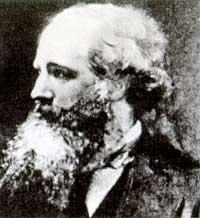Maxwell, James Clerk
(1831-1879)
This prestigious Scottish physicist was born in Edinburgh in 1831, within a well-known and wealthy family. From a very young age he was able to prove his arrival in mathematics. He was the only friend of the school who had mathematics and devoted many hours to his monologue seeking laws that were not known until then. His companions told him that this hobby would confuse him, so they called him "crazy."
At fifteen he wrote a small work on the design of elliptical curves and presented it at the "Royal Society" in Edinburgh. Members of the association recognized that the research work was excellent, but accused the boy of plagiarism.
In 1854 he received his doctorate from the University of Cambridge. Two years later he was offered a teaching position at the Aberdeen school and in 1860 he joined the Royal School of London.

He was still a student when he began researching Saturn's rings. Maxwell thought that the structure of these rings could not be rigid, as it would completely reduce gravitational forces. As Maxwell postulated, each ring of Saturn is a beam of dynamically stable particles that by their distance seem to have a solid structure.
Since 1860 he dealt with the driving force of gas molecules. The first research on the kinetic theory of gases was carried out in collaboration between Maxwell and Boltzmann and since then consolidated the theory announced by Rumford that heat is a type of movement.
1871 n Maxwell returns to Cambridge, this time as a professor of experimental physics. Throughout his career, he created a magnificent laboratory, which he called Cavendish, in honor of the English scientist.
Maxwell performed his most important work between 1864 and 1873. Maxwell developed the theory of magnetic force lines that Faraday advanced and gave them a mathematical formulation. He dictated the general laws of the electromagnetic field in 1873, completing his previous theory 8 years earlier. He is therefore the first researcher to combine electricity with the theories of magnetism.
He also identified the light with an electromagnetic field. His theory was not immediately accepted; more specifically, until it was experimentally demonstrated that the speed of light is the same as that of electromagnetic Ain, no one took into account the theory announced by Maxwell. By then it was too late for him.
James Clerk Maxwell, a brilliant physicist considered the father of electromagnetism and kinetic theory, died the cancer at the age of 48. Death did not fail when in 1879 he went to seek Cambridge.
Buletina
Bidali zure helbide elektronikoa eta jaso asteroko buletina zure sarrera-ontzian











